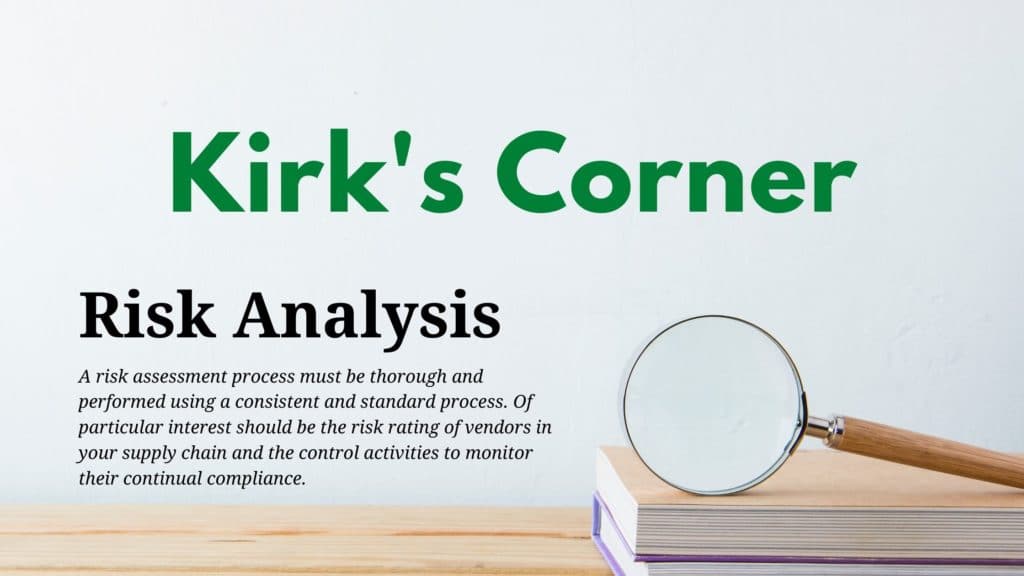
Supply chain management risk comes to the forefront in a recent cannabis flower recall. It is reported that contaminated single-use gloves were responsible for a recall of cannabis flower products from a pesticide-free cannabis producer and processor in South Lake Tahoe, California. The antimicrobial chemical o-Phenylphenol was identified as the contaminant found in the FDA-compliant food-grade gloves that the grower used. It is assumed that the glove manufacturer had previously been approved by the FDA with a compliant food-grade glove. In this product category, nonsterile FDA compliant food grade gloves are not subject to ongoing controls by the FDA to ensure compliance. In short, non-compliant activity by a vendor in the cannabis businesses supply chain triggered a product recall.
How Could This Happen
Let’s break down the process of trimming cannabis flower to identify potential risks in this common operational task. First, the cannabis flower and leaves heavily laden with trichomes are detached from the stock of the plant by an employee wearing gloves and using scissors. Typically, employees wearing gloves will take the flower and pass it through a motorized trimmer for a first pass trim. The rough trimmed flower is then hand trimmed by an employee wearing gloves and using scissors. A scissor blade and trimmer blade cleaner are used regularly to remove sticky residue from cutting instruments. An employee is likely to use some type of hand cleaner to remove any sticky trichrome residue from their hands. In this process, the cannabis flower touches or is touched by 1) gloves, 2) automatic trimmer blades and trimmer chute, 3) scissors, and 4) cleaner residue (if it exists).
You will purchase gloves, scissors, equipment cleaners, and hand cleaners on a regular basis from the vendors in your supply chain. You may also make some one-time purchases, like an automatic trimmer. It is important to develop standards for effectively vetting your vendors and be able to establish their compliance in areas that you determine are risk factors. Pay particular attention to items that will “touch” your plants.
It is important to develop standard operating procedures for employees for the flower harvesting and trimming process. This should also include the cleaning of equipment and the cleaning of hands, and when that occurs in the trimming process. You will want to ensure that you don’t have an incidental contamination event from cleaners.
Start with a Risk-Based Approach
Consider using the risk assessment format to analyze the risks:
1) Identify inherent risks in your trimming process for supplies the company relies on to produce a compliant cannabis product. Determine how likely it is that the supply fails and the impact on the company if there is a failure. This is the process of “measuring inherent risks.”
2) Identify control activities that directly address the inherent risks that you identify. This is referred to as “measure quality of controls.”
3) Evaluate the impact and likelihood that the supplies could cause non-compliance in your cannabis product after the implementation of your control activities. This is referred to as “measuring residual risk.”
4) Determine if the risk is within the company’s appetite. If not, remediate the issue.
Why Should a Company Implement a Risk-Based Approach – ACCCE
Or Use an Issue Management Process to Remediate the Issue
In this case, the cannabis company likely chose a glove manufacturer who appeared to be compliant from an FDA perspective. The subject recall illuminated an unforeseen residual risk to the company of contamination due to the vendor delivering products to the company that was not FDA compliant. The company found a failure in the quality of its vendor management control activities. The company replaces its glove supplier with another company. To reduce the risk of a repeat issue, the company visits and audits the glove manufacturer’s facility and independently tests their gloves. This glove supplier substitution greatly reduced residual risk and brought the company’s risk in line with its own risk appetite.
Conclusions
A risk assessment process must be thorough and performed using a consistent and standard process. Of particular interest should be the risk rating of vendors in your supply chain and the control activities to monitor their continual compliance. The risk measurement steps mentioned in this article will allow you to quickly identify issues in your supply chain and ensure that your business is able to operate within its risk appetite.
Kirk Barry, CCCE
The Association of Certified Commercial Cannabis Experts (ACCCE) is dedicated to advancing the professional knowledge and skills of those committed to commercial cannabis risk management.Click here for more information on how ACCCE can help our members at commercial cannabis businesses.



